Exploring the Little Island of Psara
I arrived at my little studio on Psara as the blanket of dusk was pulled over the island. My host Diana showed me around the studio and swiftly departed as fast as she whipped me away from the ferry.
The apartment is quite old school. Basic but clean and with everything that I will need for my stay – most notably air con. I was rather intrigued by the kitchen sink/electric hob/fridge combo – an all in one appliance that I haven’t seen before. There is also a gas ring to heat water in the little briki but I’m not safe with combustible appliances so I think I will stick to the hob. One needs their cups of tea! I do have a phobia about shower curtains but one I’ve been able to deal with whilst travelling around Greece. There are two single pine beds and I already get the feeling that these mattresses aren’t going to pass the “old lady creaking bones test”. Anyway, these are some of the sacrifices we have to make as travellers.
After washing the sea salt from my hair I go in search of food.
Now the main and only settlement on the island is Psara itself and the first thing that I notice is that it is primarily on the flat(ish). This has its advantages (no heaving my body up a steep hill ten times a day) and disadvantages – primarily that there are no vantage points on which to get your bearings. The village is labyrinthine in nature and the studio is right in the centre. Even with the use of Google maps I can’t seem to find my way back to the port where most of the eateries are located. Not all of the streets have lighting and the lighting that there is, is that dull tungsten lighting that casts that eery orange glow and only illuminates whatever it is next to.
A lady passes by and sees me looking confused and asks if she can help. I tell her I’m looking for a taverna. “Ah” she says and goes into her house and gets her husband. He very kindly walks me to the nearest taverna. The taverna is empty apart from the lady that runs it. The man tells me that I can look at the menu and if it’s not OK he will take me to another one. I’m sure that the taverna’s will all provide something similar so I thank the man for his help and go to speak with the lady.
I’m not massively hungry so order scordalia and sausage with a glass of white wine. I take a seat on the terrace and try to figure out where I am. The taverna is called The Eliovasilema Taverna and on Google Maps I can see that is located just behind the beach of Kato Gialos. I can’t see the beach in the dark but I can hear the waves crashing on the shore. It seems quite deserted in this part of the village. As I’d passed the other taverna’s on the harbour front it all looked quite bustling with life.
Whilst waiting for my meal I heard a squeaking under the table next to mine. At first I thought that one of the many cats playing around my feet had a squeaky toy. As I looked under the table I could see that a calico patterned cat had caught a mouse and was in the process of squeezing the life out of it with its teeth. I’m not a fan of rodents and instinctively lifted my legs up off the ground just in case the mouse managed to wriggle itself free and seek refuge up one of my trouser legs.
Once the other cats saw the calico cat’s new capture, they slowly surrounded it, laying close to the ground, watching and waiting for it to drop its prey. Feeling threatened the main cat moved to within a foot of my table still gripping the wriggling little mouse between its teeth. It isn’t going to give up its prize that easily. I say “Go away little cat. I’m not going to help you”, lifting my legs until they are almost at my chest. (I have changed the actual swear words accordingly to protect those with sensitive eyes).
The lady brings out the scordalia, bread and wine, cigarette hanging from the corner of her mouth and stops as she notices the stand off between the cats. When she sees the mouse between the teeth of the cat she laughs out loud. As she puts down the plate she points to the cat, again laughing and trying to draw my attention to it. She clearly thinks that I’ve been oblivious to the murder scene that took place in front of me. I laugh along with her through my gritted teeth and further expletives explode in my head.
I swig the wine and try to keep an eye on the location of the mouse murderer and pray it brings the mouse to a swift death. It has stopped squeaking now Thank God. Next time I look around the mouse has been discarded and is laying lifeless in the middle of the courtyard. The cats weren’t hungry. They just took sheer pleasure in the capture, the torture and the kill.
Anyway. That was my evening meal. I try and weave my way back through village now on heightened alert for a whole array of vermin that may cross my path. However, there are cats – lots of cats. On every wall, on every doorstep, around every corner, there are cats. If anything I take solace that with this feline army on constant patrol, any rodent would be taken out in an instant!
It takes a while to get back to my little studio. The landmark is a small children’s playground which sits in the middle of a cluster of houses. When I eventually arrive there I’m confused about which building it is as all of the houses seem to be built in the same square blocky style. Anyway, I eventually fathom it out and immediately star it’s location on Google Maps to make it easier next time.
I fall onto my lumpy mattress and sleep. Sort of.
**********
So today I’m off to explore the locality and to try and get my bearings. It’s so much easier to do in daylight. First things first though is to head to the bakery for breakfast. It is only a stones throw away and yet I manage to take the ‘scenic’ route to get to it. An elderly lady who runs the bakery sits on a chair outside the entrance and greets me with a welcoming smile. I order a spanokopita which I eat on my little balcony washed down with a cup of tea.
The neighbouring houses all face in towards the small playground. The elderly neighbours sit on the front step of their houses wishing passers by a “Kalimera” or “Kalispera” depending on the time of the day. I remember Diana telling me that it’s OK to leave the key to the studio in the door and I get that sense that this is a very safe place.
My explorations start at the port, where everyday life goes on. Some fishermen sit in their boats repairing nets whilst others carry out maintenance work on the quayside. Up the hill to my right, a man is hosing down a pile of sunbeds, a sign that the end of summer will soon be upon us.
The harbour wall is the first thing that you will see upon arrival and you won’t miss the striking images of the local heroes of the island that took part in the islands’ heroic yet tragic history. Also taking price of place is a painting of the island’s unique flag with the words – Freedom or Death. To understand the island’s past is to get a sense of who the people are.
It isn’t the purpose of this blog to regurgitate historical facts and to be honest, despite reading a number of different articles on the history of Psara, I don’t have the time to fact check every detail if I was to write about it. However, it is an interesting history that touches almost everything you will see and do on the island.
You can get an overview of the island’s history here: https://en.wikipedia.org/wiki/Psara
From the port you will see the name of the island set into the hillside with white stones. You will also see the sign welcoming all that arrive on the island.
Looming above the port on the western side of Psara is Mavri Rachi also known as Peleiokastro and also as the Black Ridge. It reminds me of a miniature Gibraltar rock. This was scene to so much of what happened on the island. I determine to climb it at some point during my stay. At the top there is a monument to the island’s fallen hero’s that were taken during the Psara Massacre.
At the end of the quay side on the path up to the top of Mavri Rachis is the exquisite statue of the Glory of Psara. This is a relatively modern monument created to commemorate the 200 year anniversary of the Greek Revolution and Psara’s liberation from the Ottomans. It is only when you understand the symbolism of this monument that you can truly appreciate its beauty.
The statue was a two year project by sculptor Nikolaos Giorgiou. It was inspired by the 1898 painting by Nikolaos Gyzis of the Glory of Psara who records the names of all the fallen heroes taken during the massacre of Psara.
Gyzis in turn was inspired by the poem by Dionysios Solomos written in 1825 at the time that the massacre and destruction of Psara took place.
THE DESTRUCTION OF PSARA
On the blackened spine of Psara,
Glory, pacing alone,
Broods on her shining heroes;
She crowns her hair with a band Born from the spare, few grasses That are left in the ruined land.
Dionysios Solomos 1825
To the side of the Glory of Psara is a bust of local hero Dimitrios Papanicolis who was responsible for destroying a fleet of Ottoman ships. (Thanks to Google Translate). Looking out to sea, this bust is surrounded by canons.
Walk further around the port and amongst the taverna’s and cafe’s you will see further homages to local heroes including Constantine Kanaris who along with other brave hero’s battled against the Turks and destroyed much of its fleet. Kanaris along with others that managed to escape, ended up on Evia where the settlement of Nea Evia was developed. Kanaris later in life became prime minister. It’s really hard to write about Psara without weaving in some of these notable historical facts.
Next on my agenda is to look for the Church of Agios Nikolaos – the striking church that sits high above the village. I’d caught sight of it earlier and now I’ve lost my bearings again. That’s strange as it’s higher than everything else. Again by being on the flat you lose this perspective. I eventually weave my way back through the village and realise that I should have stuck to the main road that runs along the West side of the island – once inside this maze of houses it’s easy to get lost.
I end up at the Psara Hotel which I didn’t know existed until now. A large white building that looks very modern with a well tended garden. Next to the hotel is a small stadium and also a basketball court and an outdoor gymnasium. Heading up along the side of the hotel is a steep dirt track. Here I go again – walking just to see what I can see and oblivious to what that actually may be!
It brings me up to a small church set on a hillside covered in silver grey and brown scrub, now wind battered and dead until spring. Here I can see that the dirt track continues along to St Nikolaos Church which is now in sight. I walk as far as I can go. It doesn’t seem as though this path connects with the church after all. From here I get a great view over to two other islands that make up this archipelago with Antipsara being the larger of the two. I can just about make out the long stretch of beach that Antipsara is famous for. It is possible to pay a fisherman to take you across. As much as I like the idea of seeing the beach, I don’t like the idea of being on a small islet on my own – not at my age! I head back down the dirt track and into the village.
It is now getting hot. The wind that has been with us for the last few days has dropped completely away and every degree of heat is now being felt. As I exit the maze of houses I find myself at the edge of Katsouni Beach. Instead of walking along the beach I take the road behind it which brings me between the Konaki Maritime Museum on the right and the Psara Gymnasium on the left. Google Maps says that the museum is temporarily closed which is a shame.
Once I reach the other side of the beach there is a building on a little promontory. This is the Spitalia (from the word hospital) that although looks modern, is in fact an 18th century building that served as a quarantine for returning sailors. Once the sailors had been declared ‘disease free’ they could return to the bosom of their families.
Spitalia was converted under the guidance of an architect into a restaurant but which still preserves the historical integrity of the building. It looks as though it is a seasonal business and seems as though it has been long closed. The only signs of life are the cats that seem to appear from every nook and cranny.
I walk onto the beach but don’t linger. There are sunbeds and rows of straw parasols and at the back of the beach is a picnic table under a cluster of tamarisk trees – a lovely picnic area in the shade.
Next to Spitalia is a good path that takes you down to another beach but I continue up along the main road just to explore a bit further. I’m now level with the Psara sign that is embedded into the hillside with white rocks – this can be seen as you approach the port. Also to the left is a helipad. Good to know! There are churches dotted everywhere on the landscape. It’s almost beach, church, beach, church as you walk along this stretch of road. A lot of the churches are built in a similar style, an oblong block topped with a terracotta apex roof. They look almost utilitarian compared to the elaborate churches that I’ve seen on other islands. They don’t have the soft curves of a Cycladic church for example but they do have their own unique beauty.
I arrive at a large beach called Megali Ammos – a wide beach that is backed by tamarisk trees. Although the water is as clear as crystal, the beach itself does look a little forlorn. Being backed onto what looks like some kind of industrial plant doesn’t do it any favours. I believe that from here you can cut across to another beach called Lazareta. However, I call it quits and follow the paved path back along to the small beach that I’d passed called Agia Kiriaki.
This beach is beautiful – small but perfect. You take some steps down into a little cove backed by low cliffs. The geological is amazing – the rock formation along the back of the beach has almost what looks like dividers creating compartments along the beach. The odd compartment has a kayak stowed away in there – another kayak just sits on the beach. The rock formation curves out into the sea making this a perfect little cove – oh and that crystal clear water!
The beach is a mixture of everything, from fine sand like granulated sugar, to coarser sand mixed with tiny sea shells all the way up to pebbles. Whatever is your preference in a beach you will find here. The water is just too temping and this is where I stay for the rest of the afternoon. I think that this is going to be my ‘go to’ beach!




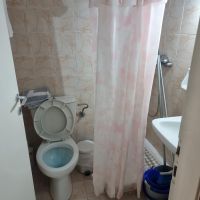
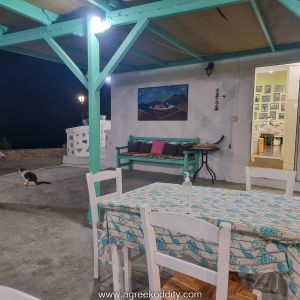

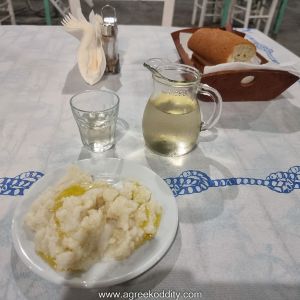


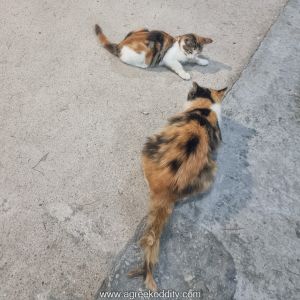

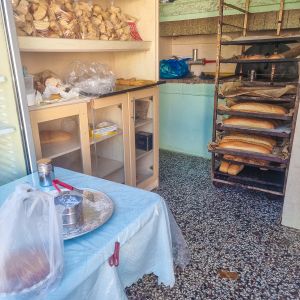
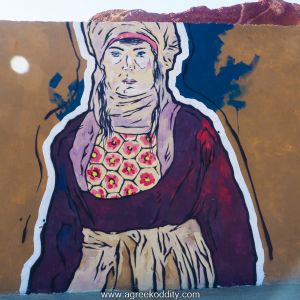
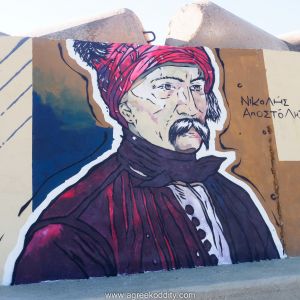
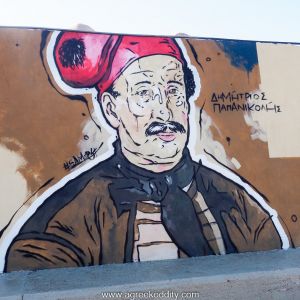

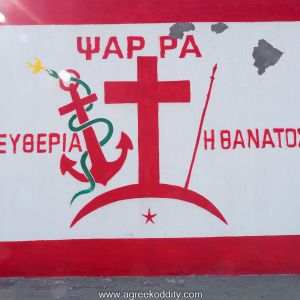
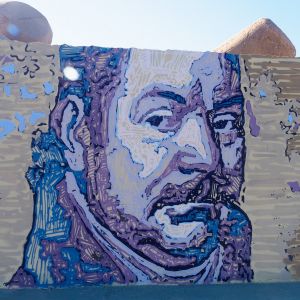
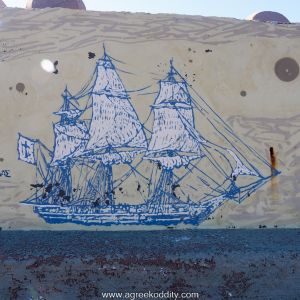
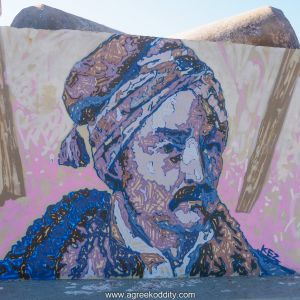
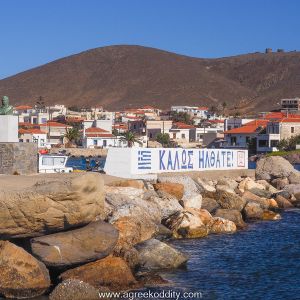

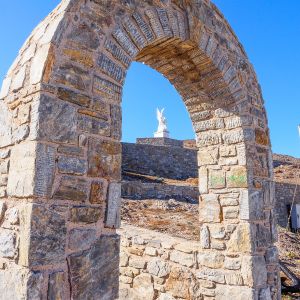
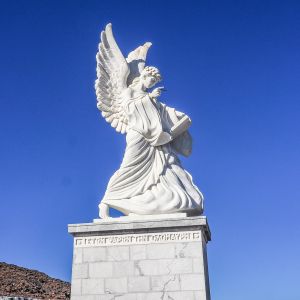
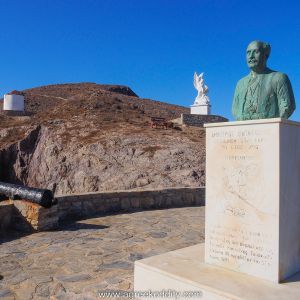
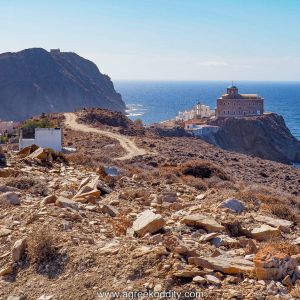
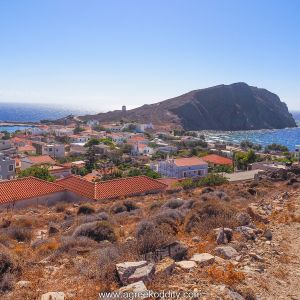

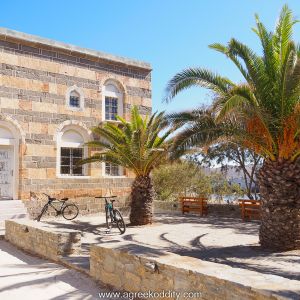
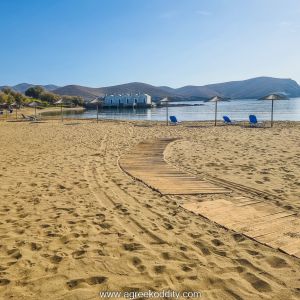
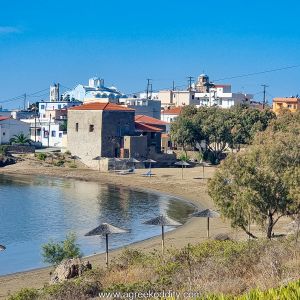
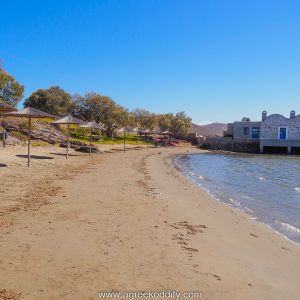

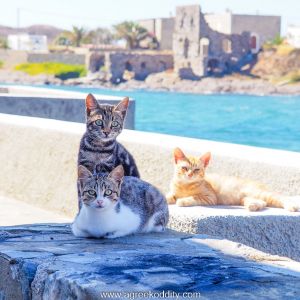


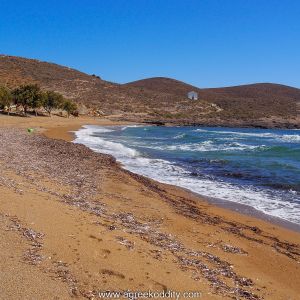
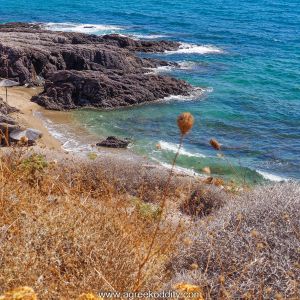

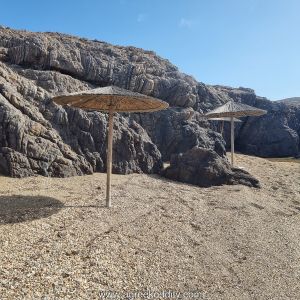

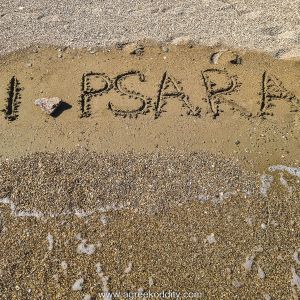
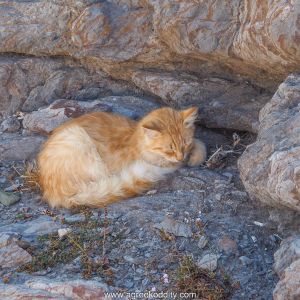






Sounds idyllic and the beaches are lovely !
Yes the beaches are really special – quite unique – and more importantly kept as natural as possible without all the shenanigans you see on a lot of beaches nowadays.
Looks beautiful – how did you get there?
Hi Sally
It isn’t easy to get to Psara. I caught a boat from Oinousses, an island to the east of Chios. There are also direct boats from Chios. You’ll see the journey that I took in other posts but this was a 7 week trip. Psara doesn’t have a lot of tourist infrastructure. There isn’t a bus service on the island for example but all the best islands are difficult to get to. ❤️